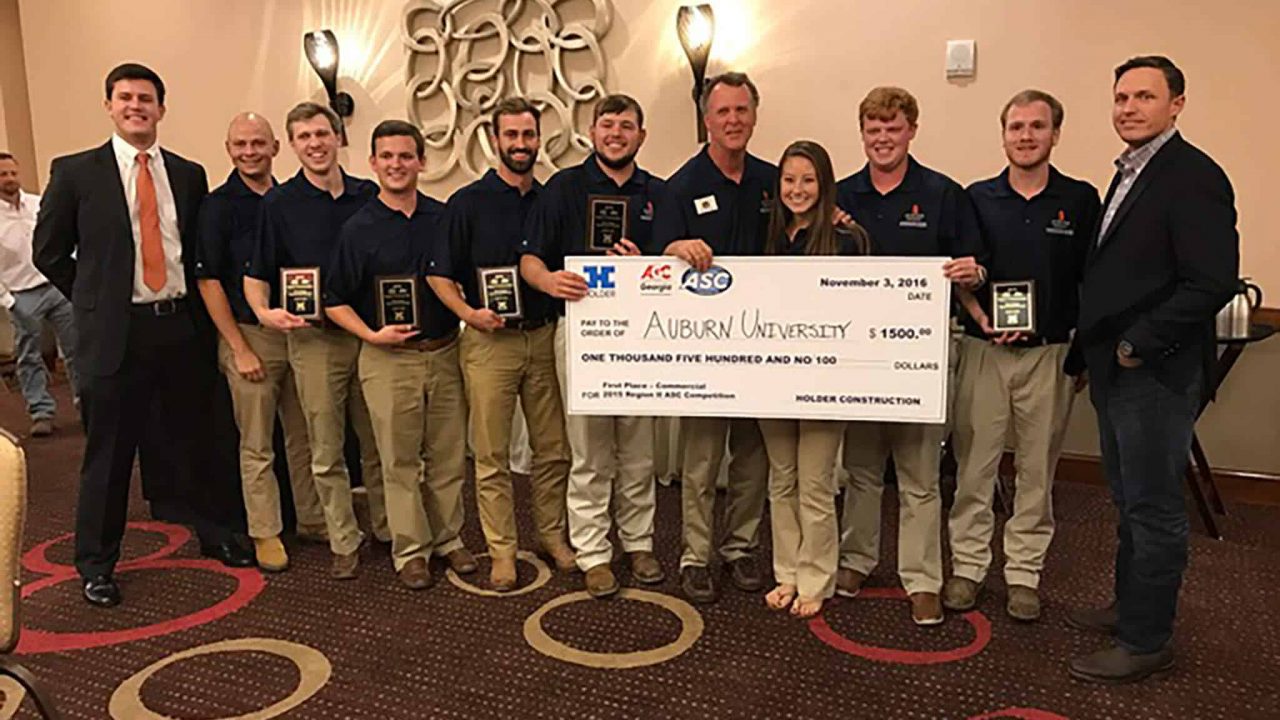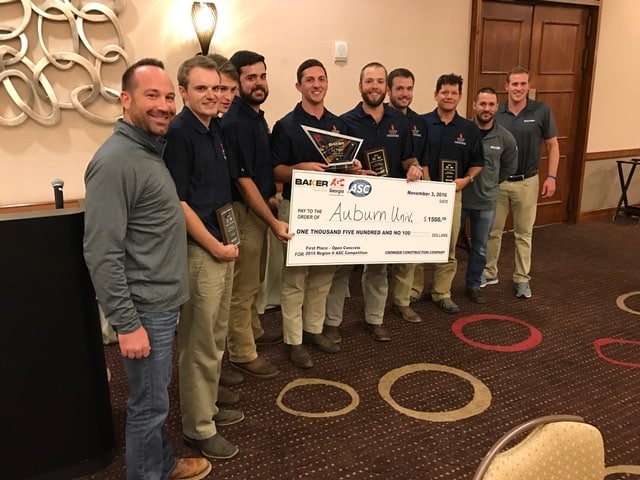Building Science Teams Place First in Three Competitions

The Associated Schools of Construction (ASC) Southeast Region (Region 2) held its annual competitions November 1-3 in Peachtree City, Georgia. The competitive events were in Open Concrete, Commercial, Design Build, Heavy Civil, and Shadow divisions. According to the organizers, nearly 200 students from 18 universities in eight states participated in the competitions that were spread over three days. Auburn University students won first place in three divisions.
According to Paul Holley, Director of Center for Construction Innovation and Collaboration (CCIC), Auburn University’s building science students have had much success in the competition over the years, with several teams placing or winning for nearly ten years.
“Our success in these competitions is a testament to the students’ commitment, competitiveness, and preparation through the BSCI curriculum,” says Holley. “Our faculty coaches work hard to prepare students not just for topical content, but also for realistic project application, presentation skills, and work under time constraints. Many of our teams also take advantage of visiting with professional practitioners as part of the preparation process, which is an invaluable experience as well as an opportunity to make industry connections.”
Open Concrete Division involved cast-in-place concrete for a multi-family High-rise project, in a very dense logistical location with very little laydown and only one crane. This division was won by Auburn University and was coached by Professor Paul Holley, and represented by Tyler Deal, Grant Quist, Mitch Long, McKelvy Douthit, Colin Thompson, and Sam Hoza. California State University Sacramento was second, and the University of Florida received Best Presentation.
The Commercial Construction Division involved a commercial project that was a 590,000 square-foot, 14-story, cast-in-place, Class-A corporate office building sitting atop a 12-story, cast-in-place, post-tension parking deck located in the Southeastern United States. The project was pursuing LEED Silver Certification and be connected to a high-traffic transit station.
Construction Management at Risk (CMAR) services required from the Construction Manager (CM) include preconstruction, construction, and post-construction phase services. These services include but are not limited to, estimating, cost management, design review, ongoing value engineering, constructability reviews/reports, building information modeling, project scheduling/sequencing, and all related reporting/communication from the schematic design phase through the warranty period. Auburn University, which took first place, was coached by Professor Mike Hosey and represented by Justin Gilliam, Sam McMath, Jake Thompson, Frank Daniel, Sarah Hoffman, Eric Brazell, John Parker, and Ben Patterson. Second Place finish went to Clemson University, and the University of Florida received Best Presentation.
Heavy Civil Construction Division involved the procurement of a public works project. The project rated student participants in several areas of heavy civil construction such as concrete placement, structural steel erection, and conventional concrete. The successful team was required to demonstrate full knowledge of plans and specification, problem-solving, construction methods, scheduling techniques, estimating, risk management and communication skills. Auburn University won the competition and was coached by Professor Alan Bugg, and represented by Josh Atkinson, Andrew Holder, Thomas Rush, John Sasser, Breck Tillery, and James Pickard. The University of Florida placed second, and Mississippi received the Best Presentation category.
The Design Build team was coached by Professor Darren Olsen and represented by Auburn and Tuskegee University students Erin Allee, Chase Merrill, Katie Bobo, and Monica Fernandez. The team was required to submit a proposal for design build services for the design and construction of a new location for an existing health care client to serve non-health care support staff. The proposal had to include design, estimating/cost management, constructability reviews incorporated into design decisions, building information modeling (BIM), project scheduling, construction safety, and means of management for both the design and construction of the project along with their integration for overall benefit through this delivery method. LEED certification was encouraged, but energy-saving elements were required to be incorporated into the project.
The ASC is the professional association for the development and advancement of construction education, where the sharing of ideas and knowledge inspires, guides and promotes excellence in curricula, teaching, research and service.


See more in:
Student Accolades,
Student Competitions
Related people:
Paul Holley,
Alan Bugg,
Darren Olsen